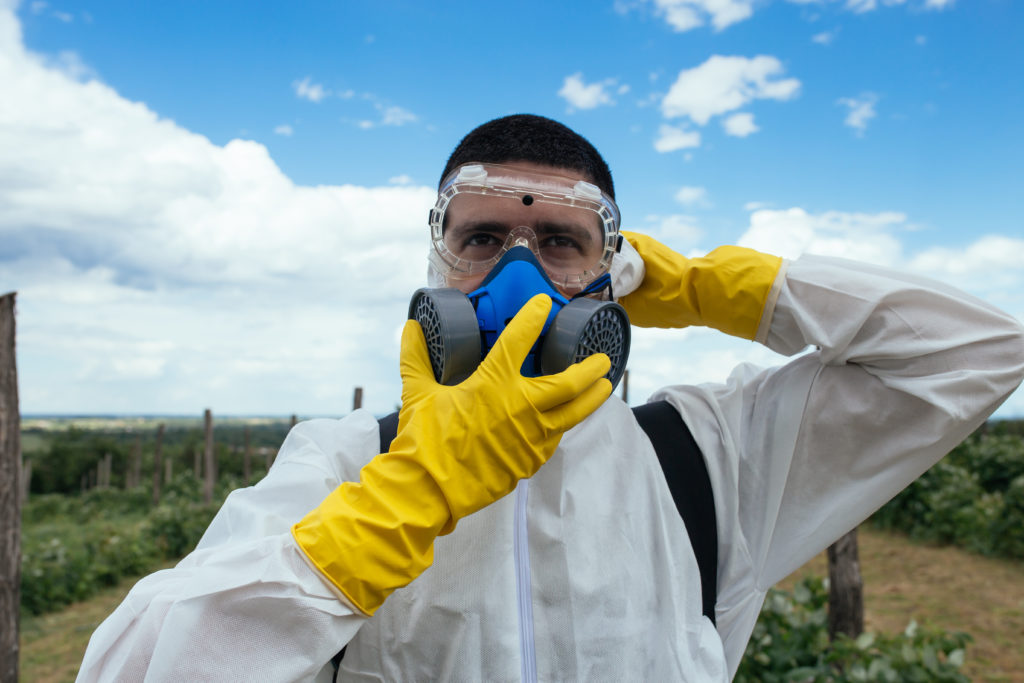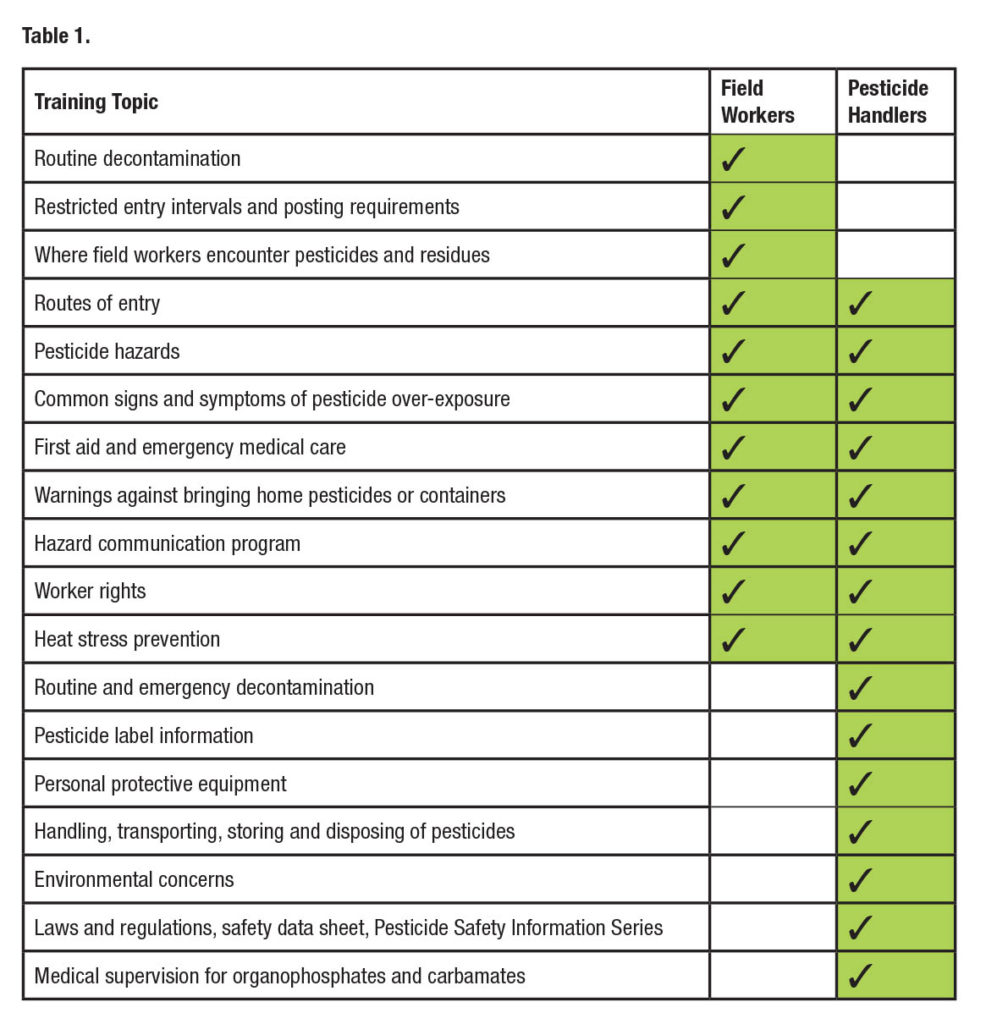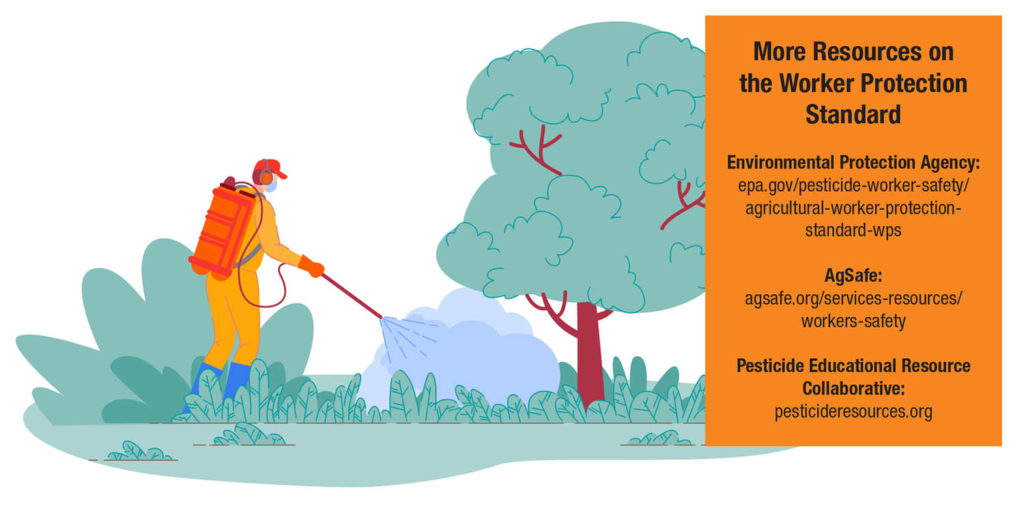By Natalie Gupton
Whether you are a conventional or organic grower, pesticide use is fully engrained in modern farming techniques. Technological advances have led to more enhanced chemistry, precisely targeting devastating diseases and pests. However, if not handled properly, pesticides pose significant risks.

The Environmental Protection Agency (EPA) estimates that 10,000 to 20,000 physician-diagnosed pesticide poisonings occur every year among the 2 million farmworkers nationwide. Many of these incidents could be avoided with practical education. Subsequently, federal law requires individuals to be licensed to use, handle or apply certain pesticides to ensure safety.
Specifically, the Worker Protection Standard (WPS) is an EPA law that began in 1995, expanded in 2015 and became fully enforceable in 2017. WPS is applicable to any agricultural establishment (farms, forests, nurseries and greenhouses) that employs anyone who is either classified as a Pesticide Handler or an Agricultural Worker/Field Workerwho may have an occupational exposure to agricultural pesticides. WPS is applicable if you are one of the following:
- The owner or a person responsible for the management of an agricultural establishment that employs workers or handlers
- The owner or a person responsible for the management of a commercial (for-hire) pesticide handling establishment
- A pesticide handler
- A crop advisor
EPA’s WPS aims to reduce pesticide poisonings and injuries by mandating various activities, including an annual pesticide safety training. Employees must receive WPS training on several topics (see Table 1) before they perform any worker or handler task.

Providing comprehensive training is critical to effective pesticide safety. Reviewing general safety, decontamination procedures, hazard communication and the pesticide label are the cornerstones of a WPS-compliant program. Following are a few things to keep in mind when developing your operation’s training program.
GENERAL SAFETY
Employees who handle pesticides must be at least 18 years old and trained how to protect themselves. Individuals who handle pesticides in agriculture, including loading and applying pesticides; repairing or cleaning equipment that was used for pesticides; repairing or removing tarps on a field; or touching unrinsed pesticide containers must receive information on the potential health effects of pesticide exposure. Those working with pesticides should keep these points in mind:
- Pesticides can get into the body many different ways and can have both immediate (acute) and long-term (chronic) effects on health.
- Pesticides can cause illness by moving into the body through skin, mouth, eyes or lungs.
- An acute health affect occurs immediately after exposure to pesticide.
- Chronic health effects can occur after being exposed to a pesticide for a long period of time before symptoms or sickness are seen.
DECONTAMINATION PROCEDURES
Employers must establish accessible decontamination supplies located together within a quarter-mile of all workers and handlers. Decontamination supplies should consist of the following:
- 1 gallon of water per worker and 3 gallons of water per handler at the beginning of each work period for routine and emergency decontamination
- Plenty of soap and single-use towels.
- A clean coverall (or other clean change of clothes) for handlers
- Provide water that is safe and cool enough for washing, eye-flushing and drinking. Do not use water that is also used for mixing pesticides unless steps are taken to ensure safety.
- Provide handlers with decontamination supplies where personal protective equipment (PPE) is removed at the end of a task.
HAZARD COMMUNICATION
Pesticide safety, application and hazard information must be displayed at a central location that is always readily accessible during normal work hours and can be easily seen and read by workers and handlers. This includes the following:
- Application information must include the product name, EPA registration number and active ingredient, crop or site treated, location and description of the treated area, date, start and end times of the application, and duration of restricted-entry interval (REI).
- A copy of the safety data sheet (SDS) for the formulated product for each WPS-labeled pesticide applied
- Display a current EPA WPS safety poster (or equivalent information) where decontamination supplies are located at permanent sites and where decontamination supplies are provided for 11 or more workers.
Be sure to display the SDS and application information within 24 hours of the application and before workers enter treated areas. This information must be displayed for 30 days after the REI expires and kept in records on the agricultural establishment until two years after the REI expires. Also, be sure to provide the SDS and application information upon request of a worker, handler, designated representative or medical personnel within 15 days.
PESTICIDE LABEL
The label is the law, and it is critical to review the product information with employees prior to application. On the pesticide label, pay close attention to the product name, chemical name, formulation, signal word, first aid, statement of practical treatment, precautionary statements, PPE for handlers and user safety recommendations.
Natalie Gupton (natalie@agsafe.org) is vice president and chief operating officer of AgSafe in Louisville, Kentucky.










